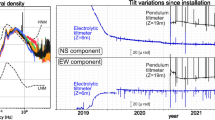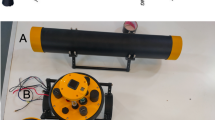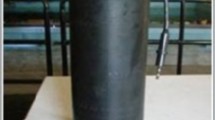Abstract
Sensitive Ocean Bottom Implanted Tiltmeters (OBITs) with a sophisticated data retrieval system have been developed in order to observe directly the subduction of oceanic lithosphere. The OBIT is the first long-term geophysical instrument which was designed to be deployed by a manned deep-sea submersible. When the OBIT is put on oceanic lithosphere which is bending and is about to subduct under a deep sea trench, the OBIT records the subduction by observing the tilt of the surface of the lithosphere. The OBIT system has a sensitivity of 10-8 radian, which is enough to detect the ongoing subduction in months or years. The OBIT may give an answer to the question whether there are fluctuations in the subduction rate.
Two OBITs were successfully deployed on a seaward slope of the Kuril Trench by the newly built French deep submersible, Nautile. The OBITs were installed on the northwest shoulder of Erimo seamount, at a depth of 3930 m, in the Kuril Trench. In order to attain stable long-term observations of crustal deformations, the sensing unit was cemented onto bare rock by mortar. We have not yet had an opportunity to recover the data.
The life of the instruments is expected to be more than five years. An acoustic data transmission system has been developed for the OBIT data recovery. The stored data can be retrieved at any moment during the observation period, with no need to retrieve the instruments nor to interrupt the observation, by use of the acoustic system. The acoustic system has a high data transmission rate as well as extremely low power consumption. This will be the first long-term crustal deformation measurement on the sea floor.
Similar content being viewed by others
References
Agnew, D. C., 1986, Strainmeters and Tiltmeters, Rev. Geophys. 3, 579–624.
Butler, R. and Duennebier, F. K., 1986, Seismic Observation from an Ocean Subbottom Seismometer in the Northwest Pacific Basin, Bulletin of the Seismological Society of America 76, 565–577.
Cadet, J. P., Kobayashi, K., Lallemand, S., Jolivet, L., Aubouin, J., Boulegue, J., Dubois, J., Hotta, H., Ishii, T., Konishi, K., Niitsuma, N., and Shimamura, H. 1987, Deep Scientific Dives in the Japan and Kuril Trenches, Earth Planet. Sci. Lett 83, 313–328.
Kaiko I Research Group, 1985, Detailed Topography of Trenches and Troughs Around Japan, Ocean Research Institute, Tokyo Univ., Tokyo, 59 pp.
Kaiko I Research Group, 1986, Topography and Structure of Trenches Around Japan — Data Atlas of Franco-Japanese Kaiko Project, Phase I, Ocean Research Institute, Tokyo Univ., Tokyo, 305 pp.
LePichon, X., Kobayashi, K., Cadet, J. P., Iiyama, T., Nakamura, K., Pautot, G., Renard, V., and the Kaiko Scientific Crew, 1987, Project Kakio—Introduction, Earth Planet. Sci. Lett. 83, 183–185.
Minster, J. B. and Jordan, T. H., 1978, ‘Present-day Plate Motions’, J. Geophys. Res. 83, 5331–5354.
Minster, J. B. and Jordan, T. H., 1979, Rotation Vectors for the Philippine and Rivera Plates, EOS 60, 958.
Nakamura, K., 1982. Relation between Rates of Subsidence and Subduction at the Suruga Bay, Zisin, Ser. 2, 35, 133–135 (in Japanese).
Pautot, G., Nakamura, K., Huchon, P., Angelier, J., Bourgoir, J., Fujioka, K., Kanazawa, T., Nakamura, Y., Ogawa, Y., Seguret, M., and Takeuchi, A., 1987, Deep-sea Submersible Survey in the Suruga, Sagami and Japan Trenches: Preliminary Results of the 1985 Kaiko Cruise, Leg 2, Earth Planet. Sci. Lett. 83, 300–312.
Seno, T., 1977, The Instantaneous Rotation Vector of the Philippine Sea Plate Relative to the Eurasian Plate, Tectonophysics 42, 209–226.
Seno, T. and Eguti, T., 1983, Seismotectonics of the Western Pacific Region, in Hilde, T. W. C. and Uyeda, S. (eds.), Geodynamics Series 11, Geodynamics of the Western Pacific-Indonesian Region, 5–40.
Spiess, F. N., 1985a, Analysis of a Possible Sea Floor Strain Measurement System, Mar. Geod. 9(4), 385–398.
Spiess, F. N., 1985b, Suboceanic Geodetic Measurements, IEEE Trans. Geosci. & Remote Sensing, GE-23 (4), 502–510.
Utsu, T., 1977, Seismology, Kyoritsu-Shuppan, Tokyo, 286 pp. (in Japanese).
Author information
Authors and Affiliations
Rights and permissions
About this article
Cite this article
Shimamura, H., Kanazawa, T. Ocean bottom tiltmeter with acoustic data retrieval system implanted by a submersible. Mar Geophys Res 9, 237–254 (1988). https://doi.org/10.1007/BF00309975
Received:
Accepted:
Issue Date:
DOI: https://doi.org/10.1007/BF00309975




